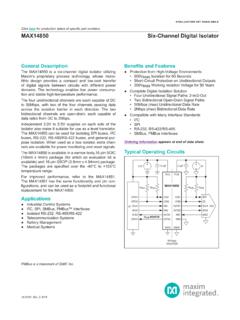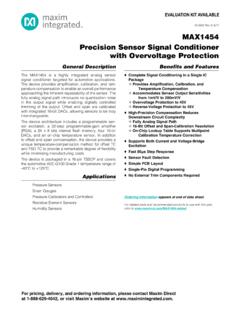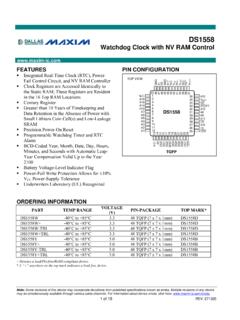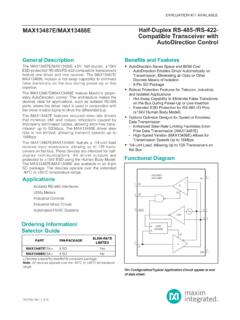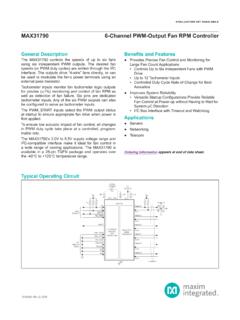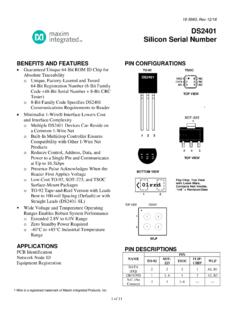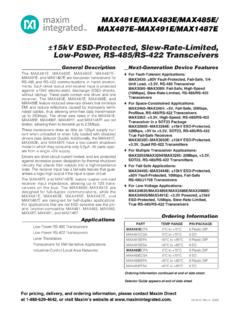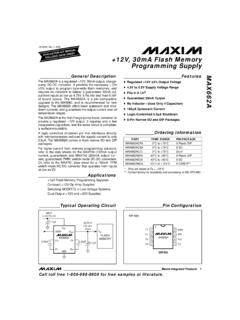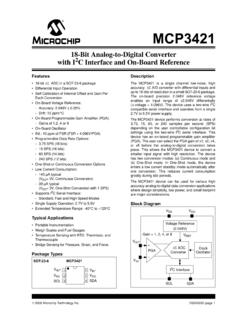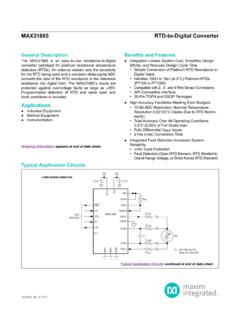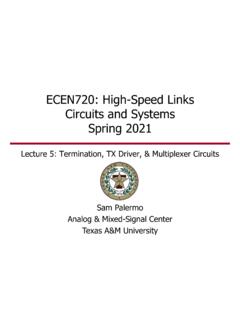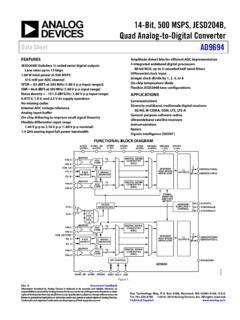Transcription of here to ask about the production status of specific part …
1 EVALUATION KIT AVAILABLE. Click here to ask about the production status of specific part numbers. MAX6675 Cold-Junction-Compensated K-Thermocouple- to- digital converter (0 C to +1024 C). General Description Features The MAX6675 performs cold-junction compensation and Direct digital Conversion of Type -K Thermocouple digitizes the signal from a type-K thermocouple. The data Output is output in a 12-bit resolution, SPI-compatible, read-only Cold-Junction Compensation format. Simple SPI-Compatible Serial Interface This converter resolves temperatures to C, allows readings as high as +1024 C, and exhibits thermocouple 12-Bit, C Resolution accuracy of 8 LSBs for temperatures ranging from 0 C to Open Thermocouple Detection +700 C. The MAX6675 is available in a small, 8-pin SO package. Ordering Information Applications PART TEMP RANGE PIN-PACKAGE. Industrial MAX6675 ISA -20 C to +85 C 8 SO. Appliances HVAC. Pin Configuration Typical Application Circuit TOP VIEW Vcc F.
2 GND 1 8 MAX6675. GND MICROCONTROLLER. T- 2 7 SO. MAX6675 68HC11A8. SO MISO. T+ 3 6 CS. T+ SCK SCK. VCC 4 5 SCK. T- CS SSB. SO. 19-2235; Rev 3; 6/21. MAX6675 Cold-Junction-Compensated K-Thermocouple- to- digital converter (0 C to +1024 C). Absolute Maximum Ratings Supply Voltage (VCC to GND) .. to +6V Storage Temperature Range .. -65 C to +150 C. SO, SCK, CS, T-, T+ to GND .. to VCC + Junction Temperature .. +150 C. SO Current .. 50mA SO Package ESD Protection (Human Body Model) .. 2000V Vapor Phase (60s) ..+215 C. Continuous Power Dissipation (TA = +70 C) Infrared (15s) .. +220 C. 8-Pin SO (derate C above +70 C) .. 471mW Lead Temperature (soldering, 10s) .. +300 C. Operating Temperature Range .. -20 C to +85 C. Stresses beyond those listed under Absolute Maximum Ratings may cause permanent damage to the device. These are stress ratings only, and functional operation of the device at these or any other conditions beyond those indicated in the operational sections of the specifications is not implied.
3 Exposure to absolute maximum rating conditions for extended periods may affect device reliability. Electrical Characteristics (VCC = + to + , TA = -20 C to +85 C, unless otherwise noted. Typical values specified at +25 C.) (Note 1). PARAMETER SYMBOL CONDITIONS MIN TYP MAX UNITS. TTHERMOCOUPLE = +700 C, VCC = + -5 +5. TA = +25 C (Note 2) VCC = +5V -6 +6. TTHERMOCOUPLE = 0 C to VCC = + -8 +8. Temperature Error LSB. +700 C, TA = +25 C (Note 2) VCC = +5V -9 +9. TTHERMOCOUPLE = +700 C VCC = + -17 +17. to +1000 C, TA = +25 C (Note 2) VCC = +5V -19 +19. Thermocouple Conversion V/LSB. Constant Cold-Junction TA = -20 C t o VCC = + + C. Compensation Error +85 C (Note 2) VCC = +5V + Resolution C. Thermocouple Input 60 kW. Impedance Supply Voltage VCC V. Supply Current ICC mA. Power-On Reset Threshold VCC rising 1 2 V. Power-On Reset Hysteresis 50 mV. Conversion Time (Note 2) s SERIAL INTERFACE. x Input Low Voltage VIL V. VCC. x Input High Voltage VIH V. VCC.
4 Input Leakage Current ILEAK VIN = GND or VCC 5 A. Input capacitance CIN 5 pF. Maxim Integrated 2. MAX6675 Cold-Junction-Compensated K-Thermocouple- to- digital converter (0 C to +1024 C). Electrical Characteristics (continued). (VCC = + to + , TA = -20 C to +85 C, unless otherwise noted. Typical values specified at +25 C.) (Note 1). PARAMETER SYMBOL CONDITIONS MIN TYP MAX UNITS. VCC - Output High Voltage VOH ISOURCE = V. Output Low Voltage VOL ISINK = V. TIMING. Serial Clock Frequency fSCL MHz SCK Pulse High Width tCH 100 ns SCK Pulse Low Width tCL 100 ns CSB Fall to SCK Rise tCSS CL = 10pF 100 ns CSB Fall to Output Enable tDV CL = 10pF 100 ns CSB Rise to Output Disable tTR CL = 10pF 100 ns SCK Fall to Output Data Valid tDO CL = 10pF 100 ns Note 1: All specifications are 100% tested at TA = +25 C. Specification limits over temperature (TA = TMIN to TMAX) are guaranteed by design and characterization, not production tested. Note 2: Guaranteed by design.
5 Not production tested. Typical Operating Characteristics (VCC = + , TA = +25 C, unless otherwise noted.). OUTPUT CODE ERROR OUTPUT CODE ERROR. vs. AMBIENT TEMPERATURE vs. VOLTAGE DIFFERENTIAL. 10 10. MAX6675 toc01. MAX6675 toc02. OUTPUT CODE ERROR (LSB). 8. OUTPUT CODE ERROR (LSB). 5. 6. 4. 0. 2. 0 -5. 0 15 30 45 60 75 90 -10 0 10 20 30 40 50. TEMPERATURE ( C) VOLTAGE DIFFERENTIAL (mV). Maxim Integrated 3. MAX6675 Cold-Junction-Compensated K-Thermocouple- to- digital converter (0 C to +1024 C). Pin Description Where: PIN NAME FUNCTION VOUT is the thermocouple output voltage ( V). 1 GND Ground TR is the temperature of the remote thermocouple junc- tion ( C). Alumel Lead of Type-K Thermocouple. 2 T- Should be connected to ground externally. TAMB is the ambient temperature ( C). 3 T+ Chromel Lead of Type-K Thermocouple Cold-Junction Compensation Positive Supply. Bypass with a F The function of the thermocouple is to sense a differ- 4 VCC. capacitor to GND.
6 Ence in temperature between two ends of the thermo- 5 SCK Serial Clock Input couple wires. The thermocouple's hot junction can be Chip Select. Set CS low to enable the serial read from 0 C to + C. The cold end (ambi- 6 CS ent temperature of the board on which the MAX6675. interface. is mounted) can only range from -20 C to +85 C. 7 SO Serial Data Output While the temperature at the cold end fluctuates, the 8 No Connection MAX6675 continues to accurately sense the tempera- ture difference at the opposite end. Detailed Description The MAX6675 senses and corrects for the changes in the ambient temperature with cold-junction compen- The MAX6675 is a sophisticated thermocouple-to-digi- sation. The device converts the ambient temperature tal converter with a built-in 12-bit analog-to- digital con- reading into a voltage using a temperature-sensing verter (ADC). The MAX6675 also contains cold-junction diode. To make the actual thermocouple temperature compensation sensing and correction, a digital con- measurement, the MAX6675 measures the voltage from troller, an SPI-compatible interface, and associated the thermocouple's output and from the sensing diode.
7 Control logic. The device's internal circuitry passes the diode's volt- The MAX6675 is designed to work in conjunction with an age (sensing ambient temperature) and thermocouple external microcontroller ( C) or other intelligence in ther- voltage (sensing remote temperature minus ambient mostatic, process-control, or monitoring applications. temperature) to the conversion function stored in the ADC to calculate the thermocouple's hot-junction tem- Temperature Conversion perature. The MAX6675 includes signal-conditioning hardware to convert the thermocouple's signal into a voltage compat- Optimal performance from the MAX6675 is achieved ible with the input channels of the ADC. The T+and T- when the thermocouple cold junction and the MAX6675. inputs connect to internal circuitry that reduces the intro- are at the same temperature. Avoid placing heat-gen- duction of noise errors from the thermocouple wires. erating devices or components near the MAX6675.
8 Because this may produce cold-junction-related errors. Before converting the thermoelectric voltages into equivalent temperature values, it is necessary to com- Digitization pensate for the difference between the thermocouple The ADC adds the cold-junction diode measurement cold-junction side (MAX6675 ambient temperature) and with the amplified thermocouple voltage and reads out a 0 C virtual reference. For a type-K thermocouple, the the 12-bit result onto the SO pin. A sequence of all voltage changes by 41 V/ C, which approximates the zeros means the thermocouple reading is 0 C. A. thermocouple characteristic with the following linear sequence of all ones means the thermocouple reading equation: is + C. VOUT = (41 V / C) x (TR - TAMB). Maxim Integrated 4. MAX6675 Cold-Junction-Compensated K-Thermocouple- to- digital converter (0 C to +1024 C). Applications Information Thermal Considerations Serial Interface Self-heating degrades the temperature measurement accuracy of the MAX6675 in some applications.
9 The The Typical Application Circuit shows the MAX6675 magnitude of the temperature errors depends on the interfaced with a microcontroller. In this example, the thermal conductivity of the MAX6675 package, the MAX6675 processes the reading from the thermocou- mounting technique, and the effects of airflow. Use a ple and transmits the data through a serial interface. large ground plane to improve the temperature mea- Force CS low and apply a clock signal at SCK to read surement accuracy of the MAX6675. the results at SO. Forcing CS low immediately stops any conversion process. Initiate a new conversion The accuracy of a thermocouple system can also be process by forcing CS high. improved by following these precautions: Force CS low to output the first bit on the SO pin. A Use the largest wire possible that does not shunt complete serial interface read requires 16 clock cycles. heat away from the measurement area. Read the 16 output bits on the falling edge of the clock.
10 If small wire is required, use it only in the region of The first bit, D15, is a dummy sign bit and is always the measurement and use extension wire for the zero. Bits D14 D3 contain the converted temperature region with no temperature gradient. in the order of MSB to LSB. Bit D2 is normally low and Avoid mechanical stress and vibration, which could goes high when the thermocouple input is open. D1 is strain the wires. low to provide a device ID for the MAX6675 and bit D0. is three-state. When using long thermocouple wires, use a twisted- pair extension wire. Figure 1a is the serial interface protocol and Figure 1b shows the serial interface timing. Figure 2 is the SO out- Avoid steep temperature gradients. put. Try to use the thermocouple wire well within its tem- perature rating. Open Thermocouple Use the proper sheathing material in hostile environ- Bit D2 is normally low and goes high if the thermocou- ments to protect the thermocouple wire.
